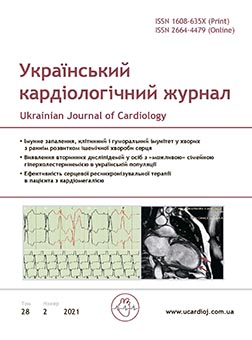Effectiveness of restoration of sinus rhythm in patients with combined atrial fibrillation and atrial flutter
Main Article Content
Abstract
The aim – to compare the effectiveness of restoration of sinus rhythm by transesophageal pacing (TEECP) in patients with prolonged episodes of isolated typical atrial flutter (AFl) and in patients with a combination of atrial fibrillation (AF) and AFl.
Materials and methods. 325 procedures of TEECP were performed in cases of longlasting episodes of AFl: from 8 days to 2 years (average 68.2±4.76 days). Prior to hospitalization, all subjects underwent ineffective medical cardioversion. The sinus rhythm was restored using TEECP, and in case of its ineffectiveness by means of electropulse therapy (EPT). All patients were divided into two groups: group I (n=237) – patients with a lone atrial flutter, and group II (n=88) – patients with the history of AF or in case of transformation AF into AFl because of antiarrhythmic therapy. Both groups were comparable by age, paroxysm duration, presence of hypertension and organic disorders of the heart conductive system, comorbidities, echocardiographic and hemodynamic parameters. Electrocardiographical parameters revealed no significant differences in the tachycardia cycle length and the average frequency of ventricular contractions.
Results and discussion. Patients in the group II were characterized by a significantly longer history of arrhythmia, more severe heart failure, higher frequency of arrhythmia paroxysms and detection of thyroid disorders; recorded significantly lower amplitudes of the F wave on the surface electrocardiogram and A wave on the esophageal electrogram, which was associated with the processes of electrophysiological remodeling of the atria. Also, in contrast to patients with typical AFl, there was a significant decrease in the effectiveness of TEECP (63.6 and 89 %); more frequent use of EPT (10.2 and 3 %) and more often arrhythmia has transformed into a permanent form (25 and 7.2 %).
Conclusions. In patients with prolonged episodes of typical AFl, a highly effective method of cardioversion is TEECP, regardless of the arrhythmia duration. In patients with concomitant AF, the restoration of sinus rhythm should be performed by EPT, due to its higher efficancy.
Article Details
Keywords:
References
Ардашев А.В. Трепетание предсердий: клиническая электрофизиология и катетерная абляция.– Изд. второе, исправл. и пеpеpаб.– М.: ИД «Медпрактика-М», 2012.– 232 с.
Зинченко Ю.В. Предикторы эффективной электрокардиостимуляционной кардиоверсии у больных с трепетанием предсердий // Укр. кардіол. журн.– 2009.– № 1.– С. 42–47.
Зинченко Ю.В., Вализаде Чари Джафар, Степаненко А.П. и др. Антиаритмическая подготовка перед восстановлением синусового ритма у больных с трепетанием предсердий более 7 суток // Укр. кардіол. журнал.– 2009.– № 3.– С. 42–47.
Кушаковский М.С., Гришкин Ю.Н. Аритмии сердца (Расстройства сердечного ритма и нарушения проводимости. Причины, механизмы, электрокардиографическая и электрофизиологическая диагностика, клиника, лечение). Руководство для врачей.– 4-е изд., испр. и доп.– СПб: ООО «Издательство Фолиант», 2020.– 720 с.
Сычев О.С. Фибрилляция предсердий. Современные подходы к лечению и профилактике осложнений у пациентов с сопутствующей патологией сердца // Укр. мед. часопис.– 2011.– № 6.– С. 54–58.
Al-Kaisey A., Parameswaran R., Kalman J. Atrial fibrillation structural substrates: aetiology, identification and implications // Arrhythm. Electrophysiol. Rev.– 2020.– Vol. 9 (3).–P. 113–120. doi: https://doi.org/10.15420/aer.2020.19.
Brandes A., Crijns H.J.G.M., Rienstra M. et al. Cardioversion of atrial fibrillation and atrial flutter revisited: current evidence and practical guidance for a common procedure // Europace.– 2020.– Vol. 22 (8).– P. 1149–1161. doi: https://doi.org/10.1093/europace/euaa057.
Brugada J., Katritsis D., Arbelo E. et al. 2019 ESC Guidelines for the management of patients with supraventricular tachycardia The Task Force for the management of patients with supraventricular tachycardia of the European Society of Cardiology (ESC): Developed in collaboration with the Association for European Paediatric and Congenital Cardiology (AEPC) // Eur. Heart J.– 2020.– Vol. 41, Issue 5.– P. 655–720. doi: https://doi.org/10.1093/eurheartj/ehz467.
De Vos C., Limantoro I., Pisters R. et al. The mechanical fibrillation pattern of the atrial myocardium is associated with acute and long-term success of electrical cardioversion in patients with persistent atrial fibrillation // Heart Rhythm.– 2014.– Vol. 11 (9).– P. 1514–1521. doi: https://doi.org/10.1016/j.hrthm.2014.04.029.
Ecker V., Knoery C., Rushworth G. et al. A review of factors associated with maintenance of sinus rhythm after elective electrical cardioversion for atrial fibrillation // Clin. Cardiol.– 2018.– Vol. 41 (6).– P. 862–870. doi: https://doi.org/10.1002/clc.22931.
Guichard J., Naud P., Xiong F. et al. Comparison of atrial remodeling caused by sustained atrial flutter versus atrial fibrillation // J. Am. Coll. Cardiol.– 2020.– Vol. 76 (4).– P. 374–388. doi:https://doi.org/ 10.1016/j.jacc.2020.05.062.
Hindricks G., Potpara T., Dagres N. et al. 2020 ESC Guidelines for the diagnosis and management of atrial fibrillation developed in collaboration with the European Association for Cardio-Thoracic Surgery (EACTS): The Task Force for the diagnosis and management of atrial fibrillation of the European Society of Cardiology (ESC) Developed with the special contribution of the European Heart Rhythm Association (EHRA) of the ESC // Eur. Heart J.– 2020. doi: https://doi.org/10.1093/eurheartj/ehaa612.
Jalife J., Kaur K. Atrial remodeling, fibrosis, and atrial fibrillation // Trends Cardiovasc. Med.– 2015.– Vol. 25 (6).– P. 475–484. doi: https://doi.org/10.1016/j.tcm.2014.12.015.
Johnson D., Day J., Doty J., Bunch T. Atrial fibrillation and atrial flutter: nonpharmacologic therapy // Clin. Geriatr. Med.– 2012.– Vol. 28 (4).– P. 649–663. doi: https://doi.org/10.1016/j.cger.2012.07.004.
Kapa S., Chung M., Gopinathannair R. et al. Year in review in cardiac electrophysiology // Circ. Arrhythm. Electrophysiol.– 2020.– Vol. 13 (6).– P. e008733. doi: https://doi.org/10.1161/CIRCEP.120.008733.
Lau D., Linz D., Sanders P. New findings in atrial fibrillation mechanisms // Card. Electrophysiol. Clin.– 2019.– Vol. 11 (4).– P. 563–571. doi: https://doi.org/10.1016/j.ccep.2019.08.007.
Manolis A. Contemporary diagnosis and management of atrial flutter: a continuum of atrial fibrillation and vice versa? // Cardiol. Rev.– 2017.– Vol. 25 (6).– P. 289–297. doi: https://doi.org/10.1097/CRD.0000000000000162.
Shah S., Luu S., Calestino M. et al. Management of atrial fibrillation-flutter: uptodate guideline paper on the current evidence // J. Community Hosp. Intern. Med. Perspect.– 2018.– Vol. 8 (5).– P. 269–275. doi: https://doi.org/10.1080/20009666.2018.1514932.
Thomas L., Abhayaratna W. Left Atrial Reverse Remodeling: Mechanisms, Evaluation, and Clinical Significance // JACC Cardiovasc. Imaging.– 2017.– Vol. 10 (1).– P. 65–77. doi: https://doi.org/10.1016/j.jcmg.2016.11.003.


